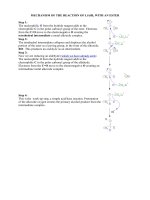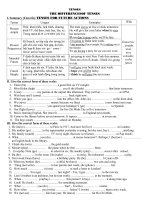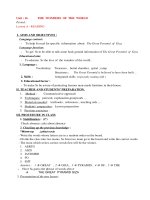Slide The scope of lexicology
Bạn đang xem bản rút gọn của tài liệu. Xem và tải ngay bản đầy đủ của tài liệu tại đây (521.36 KB, 30 trang )
LEXICOLOGY
What is lexicology?
The
word lexicology derives from Greek with lexis meaning word,
or the total stock of words and logos meaning science or theory
discourse. Thus, lexicology, a branch of linguistics, is the study of
words.
Lexicology is defined as “the study of lexis , understood as a stock
of words in a given language, i.e. its vocabulary or lexicon”
(Jackson & Amvela, 2007)
Lexicology deals with simple words in all their aspects, but also
with complex and compound words, the meaningful units of
language.
Four fields related to lexicology: Semantics, morphology,
etymology, lexicography.
Lexicology deals with simple words in all their aspects, but also with
complex and compound words, the meaningful units of language.
semantics
morphology
Four fields
related to
lexicology
lexicography
etymology
Morphology is the study of morphemes and their
arrangements in forming words.
Morphology is the study of morphemes and their arrangements in
forming words.
Morphemes are the smallest meaningful units which may constitute
words or parts of words. They are „smallest‟ or „minimal‟ in the sense
that they cannot be broken down further on the basis of meaning.
the morpheme is “the smallest unit that has meaning or serves a
grammatical function in a language. Morphemes are the atoms with
which words are built.” (Katamba 2005: 29)
They are „meaningful‟ because we can specify the kind of relationship
they have with the non-linguistic world.
im-, in-, il-, ir- are variants of the same morpheme.
Free morphemes are morphemes that can stand by
themselves as single words.
Ex: open, boy, desire, man, etc.
-lexical morphemes
Ex: girl, man, house, tiger, yellow, etc.
-functional morphemes
Ex: and, but, when, because, near, etc.
Bound morphemes which are the forms that cannot
normally stand alone and are typically attached to another
form.
-Derivational morphemes are bound morphemes to make
new words or to make words of a different grammatical
category from the stem.
List of derivational morphemes includes suffixes such as –
ish, -ly, -ment
List of derivational morphemes includes prefixes such as
re-, pre-, ex-, mis-, co-, un-Inflectional morphemes are bound morphemes to indicate
aspects of the grammatical function of a word.
Ex: -s, -ed, -ing, -er
Bound morphemes which are the forms that cannot normally stand alone
and are typically attached to another form.
Derivational morphemes are bound morphemes to make new words or to
make words of a different grammatical category from the stem.
Derivational affixes" serve to alter the meaning of a word by building on a
base, eg. –s in writes helps to form the present tense form of the verb “to
write” or when it is the predicate of a third person singular subject.
List of derivational morphemes includes suffixes such as –ish, -ly, -ment
List of derivational morphemes includes prefixes such as re-, pre-, ex-,
mis-, co-, un-
Inflectional morphemes are bound morphemes to indicate aspects of the grammatical
function of a word.
There are only eight "inflectional affixes" in English, and these are all suffixes.
English has the following inflectional suffixes, which serve a variety of grammatical
functions when added to specific types of words. These grammatical functions are
shown to the right of each suffix.
• -s noun plural: girl – girls; boy – boys; flower – flowers; ...
• -'s noun possessive: boy‟s; child‟s; student‟s; ...
• -s verb present tense third person singular: eats; sings; works; ...
• -ing verb present participle/gerund: eating; singing; working; ...
• -ed verb simple past tense: worked; played; occured; ...
• -en verb past perfect participle: eaten; taken; written; ...
• -er adjective comparative: colder; older; happier; ...
• -est adjective superlative: coldest; oldest; happiest; ...
A root may or may not stand alone as a word. It is not further divisible
into smaller parts that have a meaning.
Root creation refers to the building of a word that has no relationship
whatsoever with any previously existing word.
If roots are equivalent to a word in the language and carry the notional
meaning of this word into all the new words they form, they are
considered free roots (eg. civil in civility, region in regional or person in
personify).
A bound root is combined with other morphemes to form a meaningful
word (receive, conceive, perceive, deceive share the same bound root
which is –ceive). They are totally barred from occurring independently.
Any concrete realization of a morpheme in a given utterance is called a
„morph‟. Hence, the forms caf, chair, farm, -ing, -s, and -er are all
morphs.
Morphs are the actual forms used to realize morphemes. Ex: cats: 2
morphs (cat +-s)
Allomorphs are versions of one morpheme. Ex: -s and –es are two
allomorphs of the same morpheme “plural”
Complex words: a morpheme root + one or more affixes.
Morphs should not be confused with syllables. The basic difference between the two
is that while morphs are manifestations of morphemes and represent a specific
meaning, syllables are pairs of words which are isolated only on the basis of
pronunciation.
Simple words are all free morphemes.
Complex (or derived) words are formed from simpler words by the addition of
affixes or some other kind of morphological modification.
Compound words, or simply compounds, are formed by combining two or more
words (free morphemes) with or without morphological modification, e.g. door-knob,
cheeseburger, pound saver, wild-animal-tamer.
The construction of words and parts of words, and the distinction between the
different types of words are all based on morphological analysis.
Semantics is the study of the meaning of words, phrases and sentences.
Pragmatic semantics studies the meaning of utterances in context
Sentence semantics handles the meaning of sentences as well as
meaning relations between sentences
Lexical semantics deals with the meaning of words and the meaning
relations that are internal to the vocabulary of a language.
Philosophical semantics is concerned with the logical properties of language, the
nature of formal theories and the language of logic.
Linguistic semantics involves all aspects of meaning in natural language, from the
meaning of complex utterances in specific contexts to that of individual sounds in
syllables.
Conceptual meaning covers the basic, essential components of meaning that are conveyed
by the literal use of a word.
Associative meaning/connotation covers the components of a word. These components
would be part of the conceptual meaning.
Ex: connotations of the word „needle‟ are pain, illness, blood, drugs, thread (a
very thin fibre) or knitting.
Semantic features: basic elements in differentiating the meaning
of each word in a language from every other word.
Ex: child: [+human], [-adult]/[-mature],[ +_male]
Hen: [+animate], [+bird], [+fowl], [+grown], [+female]
Acceptability
Meaningfulness
Ex: That woman is a man.
That doll is a bomb.
That walking-stick is a gun.
Etymology
What is etymology?
Etymology can be defined as the study of the whole history of words,
not just their origin.
What are some difficulties that etymological studies face?
Some
words are not etymologically related to ancient
forms. difficult to indicate their origin.
Some terms can not be specified the exact time they
entered the language
There can be no true or original meaning
Etymology also makes reference to cognates (i.e. words
related in form) in other languages.
For borrowed words:
- Gives the source language, the date when the borrowing
took place
- Supplies the previous history of the words
lexicography
Lexicography
has been defined as “A special technique, the writing
and compilation of dictionaries”.
It also refers to the principles that underlie the process of compiling
and editing dictionaries.
Lexicology is not only the branch of linguistics providing an input
to lexicography. => morphology, syntax and phonology do.
Sociolinguistics contributes too. (language variety, information on
style and registers)
Lexicology as a level of language analysis
1. Lexicology and phonology
Ex: pill and bill, sheep and ship, meat and meal > they differ only in one
sound unit .
Suprasegmental or prosodic features such as stress can be phonological
difference between words
Ex: ex‟port (v) vs „export (n)
Stress in compounds also shows the relevance of phonology and
lexicology
Ex: a) compound
b) Noun phrase
blackboard
black board
blackbird
black bird
greyhound
grey hound
White house
white house
2. Lexicology and syntax
Syntax
is concerned with the relationships between words in
constructions and the way these words are put together to form
sentences.
Q: Are people able to speak or understand the language if they know the
meanings of all the words in a large dictionary?
If we say someone knows English, it means that they‟ve acquired a set
of rules (the rules of syntax) to produce English sentences, the rules
that help them understand the sentences of another person speaking the
language.
“Colorless green ideas sleep furiously” proposed by Chomsky (1957)
This sentence is built according to the rules of English syntax but it is
unacceptable on lexical grounds.
Syntax: general (deals with rules and regularities); lexicology: particular
(the way individual words operate and affect other words in the same
context)
1.3 The structure of English vocabulary
1.3.1 The word and its associative field
Every
word is involved in a network of associations which connect
it with other terms in the language .
These associations => similarity of meaning, purely formal (forms),
forms and meaning









